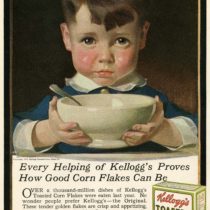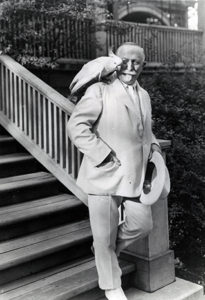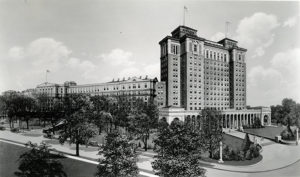Magazine

Citizen Grain
The Battle Creek Toasted Corn Flake Company, now the Kellogg Company, evolved from a whole-scale effort to return health and vitality to illness-plagued citizens across the country. But a bitter rivalry between brothers John Kellogg and W.K. Kellogg forever altered the business and the nature of their relationship. The Kellogg feud is documented in a new book by U-M Professor Dr. Howard Markel, who relied on the Bentley’s collections in his research.
By Robert Havey
When William Keith “W.K.” Kellogg founded his cereal company in 1906, it should have been a moment of triumph and joy. W.K. had overcome a hard life on the Michigan frontier to start what was soon to be a booming business and an iconic American brand. Instead, the founding of the Battle Creek Toasted Corn Flake Company (later the Kellogg Company) marked the darkest time in W.K.’s long- standing feud with his older brother, John Harvey Kellogg. Their bitter fight over the Kellogg name and legacy raged for a decade, culminating in a Michigan Supreme Court case and permanent estrangement.
The John Harvey Kellogg and the W.K. Kellogg Institute collec- tions at the Bentley were the foundation of Dr. Howard Markel’s new book, The Kelloggs: The Battling Brothers of Battle Creek. Markel, the University of Michigan’s George E. Wantz Distinguished Professor of the History of Medicine, writes that John Kellogg, the world-renowned doctor, and W.K. Kellogg, the titan of industry, both changed the way we think about health, diet, food manufacturing, and philanthropy. Their success made Kellogg a household name, but it also drove them apart.
Heath, Hygiene, and Dr. Kellogg
John Harvey Kellogg was born into a world of sickness. Six of his 16 siblings and half-siblings died of infectious diseases in a nine-year span. John contracted tuberculosis when he was very young, rendering his left lung useless his entire life. He also suffered from several painful bowel disorders, made worse by the then standard Michigan diet of overcooked grain, fried potatoes, and fatty meat.
John was a bright child, but his father was reluctant to educate him. First, there was the real possibility that the sickly boy would die from one of the myriad frontier diseases. Second, the Kellogg family was deeply tied to the Seventh-day Adventist Church, which believed the Second Coming of Jesus was going to happen any day, probably soon. Why send the boy to school when the world was about to end?
The life that the Kelloggs lived in mid-1800s Michigan would be unrecognizable today. The entire state was covered in dense pine forests. Railroads were just starting to connect distant towns. By the time John came of age, his family sold its homestead farm and moved to Battle Creek to join the congregation of Adventists. Even with his family owning a successful broom factory, John still had to milk cows, make soap, and fetch wood for the stove.

Dr. John Kellogg and his pet cockatoo “Yankee Doodle” in an undated photo. HS17832
The precocious John eventually did go to grammar school, where he excelled at reading. His intelligence was noticed by Ellen and James White, elders in the Battle Creek Seventh-day Adventist Church. They hired him at 12 years old to help in the church’s print shop, setting type and refilling ink wells.
The time with the Whites and the church was profoundly influential on John. Ellen White in particular preached a theology that was, as Markel writes, “remarkable for its emphasis on a sound body and a slate of hygienic habits, to maintain one’s physical, mental, and spiritual health.” Seventh-day Adventists believe the mind, body, and soul are an inseparable entity, so purity of body means purity of spirit.
With this new perspective and encouragement from the Whites, John decided to become a doctor. He enrolled at U-M Medical School in 1873, then Bellevue Hospital in New York City a year later. John’s curriculum at medical school was severely deficient by modern standards. Says Markel in an interview with the Bentley, “[The material taught] was closer to what was taught by Hippocrates or Galen, or medieval scholars than what is taught now. Doctors were still bleeding patients, administering arsenic and purgatives. It was not medicine we’d recognize.”
It was during this time that John started to develop ideas about health that would make him world famous. He synthesized concepts from his Seventh-day Adventist upbringing with the latest in modern physiology to come up with what he termed “biologic living.” According to Markel, John still got a lot wrong, but some of his theories were remarkably ahead of their time. John believed “exercise, fresh air, clean water, spirituality, personal hygiene, and good sleep habits,” were the keys to good health. One hundred twenty-five years before juice cleanses and Pilates, John Harvey Kellogg championed what we would now call “wellness.”
John had the perfect venue to practice his medical philosophy when he was made the director of the Battle Creek Sanitarium in 1876. The San, as it was often called, was a combination of hospital, spa, and health resort.
The multi-building complex was deeply imbued with the teachings of Seventh-day Adventistism. The phrase Mens Sana in Corpore Sano greeted each guest coming through the gates: “A healthy mind in a healthy body.”
People flocked from around the world to the San, from Amelia Earhart to Henry Ford. Battle Creek went from a remote, dusty town to the busiest train stop in Michigan after Detroit. John wrote bestselling books. He gave lectures to medical schools around the country. Kellogg became a household name.
John was able to accomplish all of this because he had his little brother W.K. running every part of his empire.
W.K. Kellogg, the Workhorse
William Keith Kellogg was born in 1860, eight years after his brother John. There was little love for W.K. in the Kellogg house. His father thought teaching him to read was a waste of time. His mother was cold and distant.
John bullied him mercilessly. Years later, W.K. dedicated his fortune to children’s charities, lamenting: “I never learned to play.”
The massive changes to society from the Industrial Revolution were making their way slowly to Battle Creek, but that didn’t exempt children like W.K. from toil. When he was six years old, his father put him to work six days a week in the broom factory. His only day off was Saturday for the Sabbath.
What W.K. lacked in formal education, he more than made up for with an incredible work ethic. He started working for his brother at the San in 1880. Soon, W.K. was running the publishing house for John’s books, managing the family health food company, and acting as administrator of the massive Sanitarium. W.K. reported working 120 hours a week for hardly any pay. Not that John showed any gratitude for W.K.’s efforts, according to Markel. A common sight on the San campus was Dr. John on his bicycle pedaling from building to building dictating his thoughts, as W.K. frantically recorded them while keeping up . . . on foot
The Origin of Cornflakes
Like every great collaborative achievement, there are end- less variations on the origin of Corn Flakes. John almost certainly had the idea for a ready-to-eat grain first. With the help of W.K. (and probably John’s wife, Ella), John spent hours in the San’s experimental kitchen making batch after batch of unpalatable wheat crumbs until finally arriving on what he called Granose. The toasted wheat flakes were an instant hit with the guests, and John instructed W.K. to start a mail-order service so San alumni could continue to buy this strange new snack.
For years following, W.K. did his own cereal experiments, refining the process. He hit upon the idea of using corn instead of wheat. Corn was a little sweeter, and W.K., unlike his brother who cared only about digestion and health, wanted his cereal to taste good. Corn Flakes was born.
To know what a revelation Corn Flakes and other cereals were, it’s important to understand the state of American breakfast in the 1800s. If you wanted to eat any sort of grain in the morning, someone would have to get up hours before the meal to put the cracked wheat, oats, or barley on the boil. Much later, the family woke up with runny porridge in their bowls: terrible tasting, but at least digestible.
Compare that to pouring Corn Flakes into a bowl. “Plain” cereals like Corn Flakes might seem boring to us now, but in 1906 they represented freedom from hours of work.
Kellogg vs. Kellogg
W.K. was desperate to launch himself into the cereal business. He saw the pathetic imitations of Corn Flakes, like C.W. Post’s Post Toasties, flying off the shelf. W.K. knew he could do better. Only one thing stood in his way: his big brother John.
John went along with the new Kellogg cereal venture at first, but his criticisms and demands of his brother only grew worse as the business succeeded. W.K. bought out John’s share of the company, but that didn’t prevent both brothers from filing lawsuits in 1910, each claiming the exclusive right to the Kellogg name.

An artist’s rendering depicts the main buildings of the Battle Creek Sanitarium. HS17838
While the battle raged in the court system, the brothers also took their fight to the free market. In 1908, John’s health food company sold a “sterilized bran” cereal very similar to Corn Flakes. The box and advertisement campaign warned against “copycat” products. W.K. responded by releasing several other “Kellogg’s” branded cereals, including “Kellogg’s Bran Crumbles,” a direct competitor to his brother’s product.
In 1920, when the lawsuits went to the Michigan Supreme Court, John had a strong case that he was the more popular Kellogg. According to Markel, “[John] was perhaps the most famous doctor in America, or at least one of them. His books were translated into [several] languages. The Battle Creek Sanitarium was a destination for people around the world. If you had heard of Kellogg’s cereal, you probably would have assumed it was connected to Dr. Kellogg.”
But it was W.K. who eventually emerged victorious. He was able to calmly and meticulously explain that the original flaked cereal envisioned by John was wheat-based, and intended as merely a health food. W.K. also showed that he had spent millions of dollars to advertise his cereal, claiming his right to the name Kellogg.
Apologies and Tragedies
Toward the end of his life, John attempted to reconcile with W.K. He penned a letter in 1941, writing, “I am sure you were right in regards to the good business. . . . I earnestly desire to make amends for any wrong or injustice of any sort I have done to you.”
The letter was never sent. John’s secretary, believing the apology was beneath the doctor’s dignity, filed it away. John died two years later, assuming W.K. had read the letter and refused to respond.
The letter was found later and delivered to W.K. in 1948. It had to be read to him by a nurse, as W.K. had gone blind from glaucoma.
“It’s hard to know,” Markel says, if there would have been a real reconciliation. “There was so much hurt, so many hard feelings. I like to think that there would be, though. They both deserved that peace.”
